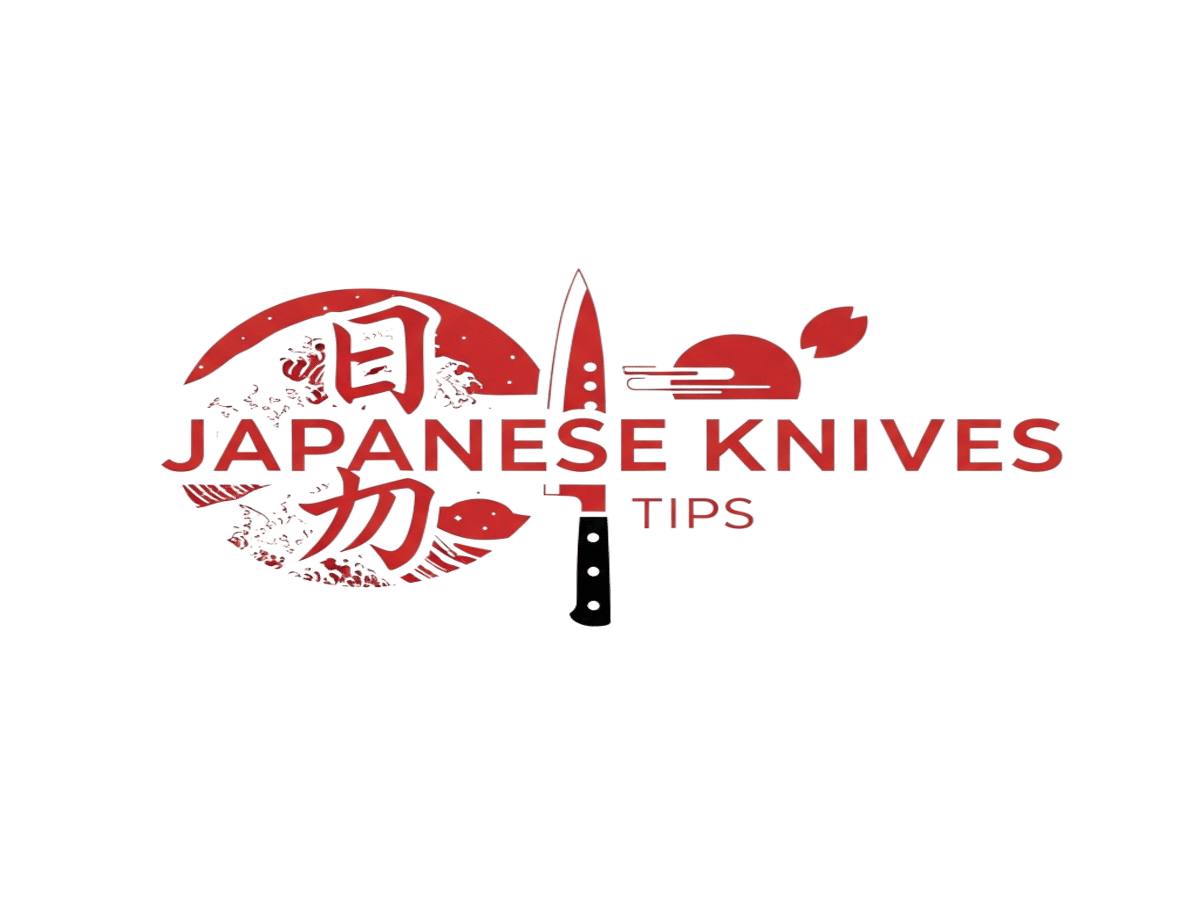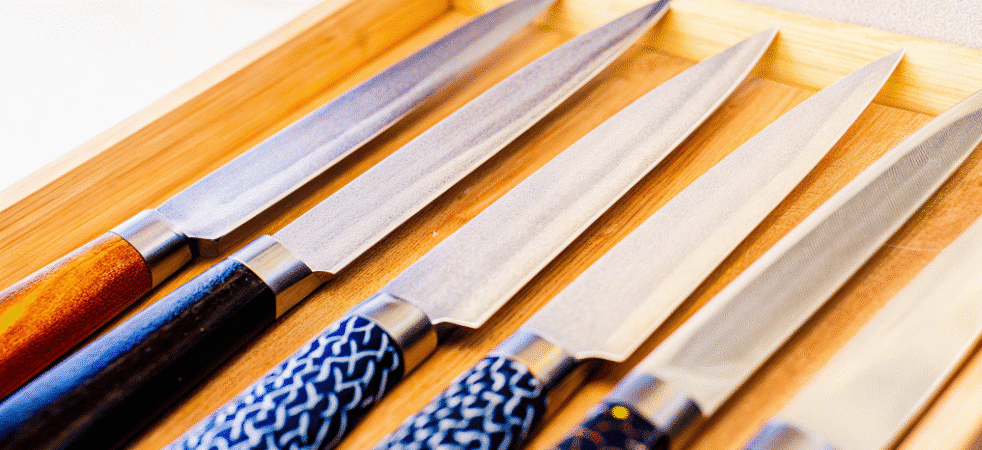Vegetable knives are a must-have for anyone who spends time in the kitchen chopping, slicing, and dicing fresh produce. Whether you’re a beginner or a seasoned cook, having the right knife can make all the difference. In this post, I’ll share what I’ve learned about vegetable knives, especially Japanese vegetable knives like nakiri knives and santoku knives, so you can pick the best one for your needs.
Japanese knives are renowned for their tradition and craftsmanship, with each style reflecting centuries of Japanese culinary culture. The nakiri knife, a type of Japanese vegetable knife, features a straight edge and rectangular blades designed for precision cuts, making it ideal for preparing vegetables with accuracy and ease.
- Introduction to Vegetable Knives
- Types of Vegetable Knives
- What Are Nakiri Knives?
- What Makes a Good Vegetable Knife?
- Nakiri vs Santoku: What’s the Difference?
- How to Use a Nakiri Knife
- Choosing the Right Blade Length and Weight
- Blade Materials and Maintenance
- Why Handle Design Matters
- What to Look for in a Nakiri Knife Credit
- Using Your Vegetable Knife Safely
- Edge Grind and Cutting Techniques
- Sharpening and Maintaining Your Knife
- How to Test a Vegetable Knife
- Top Picks for Vegetable Knives
- Accessories and Equipment
- Final Thoughts on Vegetable Knives
- FAQs About Vegetable Knives
Introduction to Vegetable Knives
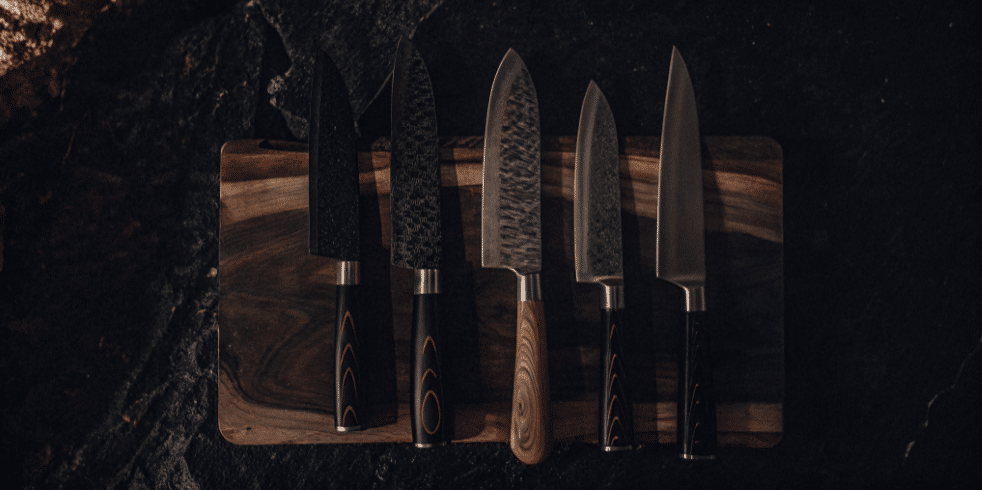
Vegetable knives are the backbone of kitchen prep. No doubt about it. Japanese vegetable knives? They’re special. Nakiri knives and santoku knives have earned their reputation. Why? Precision and ease of use. These knives are crafted with sharp blades. Thoughtful designs too. They make chopping vegetables faster. More enjoyable as well. Are you a home cook looking to upgrade? Just starting out? Understanding different types of vegetable knives helps. It helps you make the right choice. From the clean, straight cuts of a nakiri to the versatile slicing power of a santoku? These knives handle everything. Delicate herbs. Hearty root vegetables. All of it. Want to learn about their history? Their features? Their benefits? You’ll be better equipped. You’ll select the perfect knife for your kitchen. You’ll elevate your vegetable prep to a new level.
Types of Vegetable Knives
Prepping vegetables? You need the right knife. It makes all the difference. Nakiri knives are a favorite. Why? They have a straight blade. They have a rectangular shape. They excel at chopping vegetables. They excel at slicing vegetables. Their precision is amazing. Their flat edge? It touches the cutting board completely. This means clean cuts. This means even cuts. Santoku knives are different. They have a slightly curved spine. They have a flat edge too. But here’s the thing: they’re incredibly versatile. Perfect for slicing. Perfect for dicing. Perfect for mincing. Not just vegetables either. They handle meat. They handle herbs. Want more versatility? Try a bunka knife. Or consider a chef’s knife for a do-it-all tool that excels at a wide range of tasks. It features a pointed tip. This tip is great for intricate work. This tip is great for detailed slicing. Love traditional Japanese craftsmanship? The usuba knife is for you. It offers a single bevel edge. This allows ultra-thin cuts. This allows precise cuts. Professional settings love them. Each knife shape is designed for specific tasks. Each knife edge is designed for specific tasks. So here’s what to do: consider what you’ll be chopping most often. Choose a vegetable knife that matches your needs. The choice is yours.
What Are Nakiri Knives?
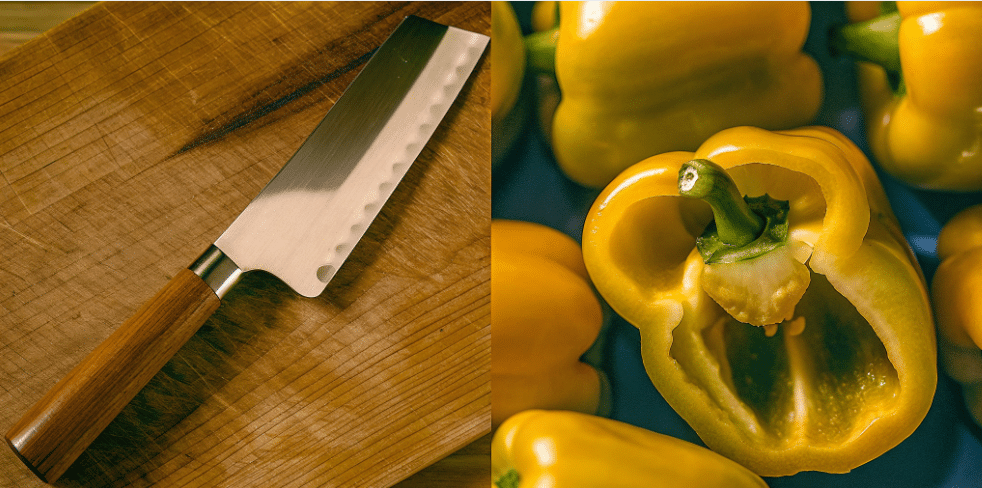
Nakiri knives are Japanese vegetable knives with a straight blade and a rectangular shape. They’re designed specifically for cutting vegetables with clean, precise cuts. The flat edge helps you chop up and down without rocking the blade, which means you get nice thin slices every time. They’re lightweight knives, which makes them easy to handle, especially when you’re prepping lots of veggies. Nakiri knives are often thinner than other vegetable knives, which helps with precision and ease of use.
One thing I like about nakiri knives is their sleek form factor. They look simple but work really well. The straight blade is perfect for chopping onions, bell pepper, sweet potato, and other hard root vegetables. Nakiri knives are often sharper than other types, allowing for cleaner, more precise cuts. Plus, they usually have a nice curve on the handle that fits comfortably in your hand, giving you a solid pinch grip.
What Makes a Good Vegetable Knife?
A good vegetable knife needs a few key features. First, the blade should be incredibly sharp right out of the box. A sharp blade means less effort required to cut through tough skins or dense vegetables. Second, the blade material matters — carbon steel blades hold their edge longer but need a bit more care, while stainless steel is easier to maintain and resists rust. Each knife shape and edge is designed for specific tasks. Different shapes of vegetable knives, such as rectangular or curved blades, can greatly affect their performance and make them more suitable for certain cutting techniques or vegetables.
Handle comfort is another big deal. Many high-quality vegetable knives have handles made from wood or pakkawood, which feels nice and natural in your hand. A mahogany handle, for example, can add a touch of elegance and grip. The knife should be well balanced, not too heavy or too light. Some chefs prefer a knife where the center of mass is about a half inch in front of the handle for optimal control and chopping performance. A heavy knife can feel like it’s doing the work for you, but it might tire your hand if you’re chopping a lot. A lightweight knife is easier to move around but might not have the same power for hard vegetables.
Nakiri vs Santoku: What’s the Difference?
Both nakiri and santoku knives come from Japanese culinary tradition, but they serve different purposes. Nakiri knives have a straight edge and are mainly for cutting vegetables. Santoku knives have a curved spine and are more versatile — they can slice meat, chop herbs, and handle other kitchen tasks besides veggies.
The nakiri’s straight blade works best with an up and down motion, which is great for chopping onions or making thin slices of bell pepper. The santoku lets you use a rocking motion, which some people prefer for general chopping. This is similar to a western style chef’s knife, which is specifically designed for a rocking motion and is a staple in many kitchens. A chef’s knife is a versatile, all-purpose tool, but specialized Japanese knives like nakiri and santoku offer more precision for vegetable prep. If you mostly cook vegetables and want cleanly slicing cuts, a nakiri knife is probably your favorite nakiri style. But if you want a jack-of-all-trades, santoku might be better.
Compared to Japanese knives, western style knives often have a curved blade, more weight, and are used with a rocking motion, while Japanese knives like nakiri and santoku focus on precision and specialized cutting techniques.
How to Use a Nakiri Knife
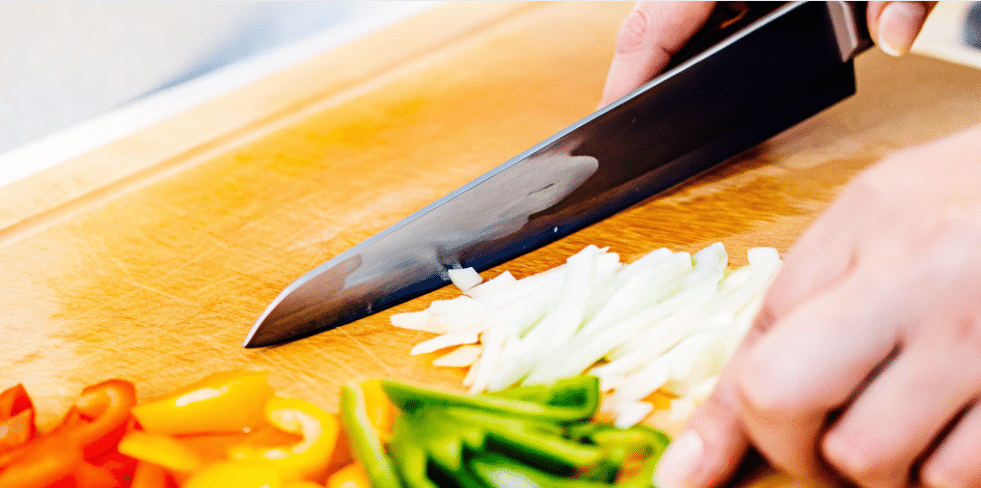
Using a nakiri knife is pretty straightforward. Hold it with a pinch grip near the bolster — that’s where the blade meets the handle. This grip gives you control and balance. Use a chopping motion, pushing the knife straight down and back up, rather than rocking it like a Western style chef’s knife. Nakiri knives can be sharpened or handled in the same way as other straight-edged knives, making maintenance straightforward.
When you’re cutting onions or bell pepper, this up and down motion keeps the slices even and prevents bruising the vegetable. It’s also great for cutting thin slices of sweet potato or chicken breast if you want to use it beyond veggies. A nakiri knife good for precise vegetable preparation and handling delicate ingredients, thanks to its straight edge and squared ends.
Choosing the Right Blade Length and Weight
Most nakiri knives have blade lengths between six and seven inches, which feels just right for most kitchen tasks. A blade that’s too long can be hard to control, and too short might slow you down. Weight is personal preference — I like a knife that’s well balanced with a little extra weight toward the blade, so it cuts through hard vegetables easily without needing to press too hard.
If you prefer a heavier handle, look for knives with a pakkawood handle that offers a nice curve and grip. Some knives have a thick blade, which adds durability but can make precise cuts harder. Thin blades are better for delicate slicing but might need more care to avoid damage. Many chefs have their favorite knives based on comfort, balance, and performance for their specific needs.
Blade Materials and Maintenance
Many vegetable knives are made from high-carbon stainless steel or carbon steel. Carbon steel knives get incredibly sharp and hold their edge well but can rust if not hand washed and dried properly. Stainless steel knives resist rust better and are easier to keep clean but might dull faster.
Some high-end nakiri knives have a Damascus steel finish, which looks beautiful with its layered pattern. This doesn’t always affect performance, but it can add a bit of extra weight. If you’re looking for a knife that’s sharp and easy to maintain, a stainless steel blade with a straight edge is a solid choice.
Why Handle Design Matters
The handle affects how comfortable the knife feels during long chopping sessions. A pakkawood handle is common and offers a smooth finish with a nice curve that fits the hand. A mahogany handle is another option that’s both durable and pleasant to hold.
Avoid handles that feel too thick or too thin for your hand size. A heavier handle can throw off the balance, making the knife harder to control. On the other hand, a lightweight handle might not feel sturdy enough. Find a handle that feels right for you — personal preference plays a big role here.
What to Look for in a Nakiri Knife Credit
When shopping for a nakiri knife, look for a brand or maker with a good reputation. A nakiri knife credit means the knife comes from a trusted craftsman or company known for quality. Reviews from professional kitchens or experienced cooks can help you find the best overall nakiri knife. Many experts also compile lists of the best nakiri knives, highlighting top choices based on sharpness, durability, and design.
Prices vary widely, from affordable options that perform well to premium knives with fancy features like hammered finishes or exotic handles. Retail prices reflect craftsmanship, materials, and brand reputation, so consider what fits your budget and needs.
Using Your Vegetable Knife Safely
Always use a cutting board when chopping vegetables to protect your knife and your countertop. Vegetables should be chopped or sliced with care to ensure even pieces and prevent accidents. Keep your fingers curled under and away from the blade to avoid accidents. Take your time when chopping, especially with hard root vegetables like sweet potatoes or dense bell peppers.
After use, hand wash your knife with warm water and mild soap. Avoid putting it in the dishwasher, as that can damage the blade and handle. Dry it thoroughly before storing it safely in a knife block or on a magnetic strip.
Edge Grind and Cutting Techniques
How does a knife’s edge affect your cooking? It makes a big difference. The way a knife’s edge is ground matters. It changes everything in the kitchen. Nakiri knives have flat edge grinds. Why does this matter? It’s perfect for chopping up and down. You can process lots of vegetables fast. That’s what you want. Santoku knives are different. They have double-bevel edges. This makes them great for push-cutting. You get less resistance when slicing. That’s smart design. But here’s the thing: technique matters too. You need to master the right cutting method. It’s just as important as picking the right knife. Want better control? Use a pinch grip. Hold the blade between your thumb and index finger. This gives you more control. Your cuts become more precise. This grip works great with Japanese vegetable knives. You can guide the blade smoothly. Each chop becomes easier. Are you slicing? Dicing? Mincing? Match your technique to your knife’s edge. This is how you get the most from your vegetable knife. It’s that simple.
Sharpening and Maintaining Your Knife
A razor-sharp blade makes cutting easier and safer. Use a whetstone or a good quality sharpening tool to keep your knife sharp. For straight blades like nakiri knives, sharpening is simpler than curved blades because you can follow the straight edge evenly.
Some nakiri knives have a single bevel, meaning only one side of the blade is sharpened. These knives require a bit more skill to sharpen but offer very precise cuts. If you’re new to sharpening, double bevel knives are easier to maintain.
How to Test a Vegetable Knife
When you try out a vegetable knife, test it on a few different foods. See how it handles chopping onions, slicing bell pepper, and cutting through sweet potato. The knife should glide through the skin without slipping or crushing the vegetable.
Pay attention to the effort required. A good knife should slice cleanly with little pressure. Also, check how comfortable the handle feels in your hand and how balanced the knife feels when you hold it.
Top Picks for Vegetable Knives
So many options out there. Finding the best nakiri knife or santoku knife? It can feel crazy. But some choices stand out. The Shun Premier Nakiri Knife is good. Really good. It has a razor-sharp blade. The handle feels right. Chopping vegetables becomes easy. The Yoshihiro VG-10 Nakiri Knife is another winner. Super sharp edge. Light weight. Perfect for thin cuts. Precise cuts. Want value? The TUO Osprey Series Nakiri Knife works. Sharp blade. Good design. Costs less. When picking your vegetable knife, think about things. Blade length matters. Weight matters. Handle shape matters too. These details change how it works. They change how it feels. What’s the best knife? The one that feels right in your hand. The one you like. It should help you get clean cuts. Even cuts. Every time.
Accessories and Equipment
Want the most from your vegetable knife? You need the right stuff. A good cutting board is key. It keeps you safe. It protects your blade too. Your knife needs to stay sharp. Why? Sharp knives are safer. They work better. Get a good sharpener. A whetstone works great. So does an electric one. Keep that edge razor-sharp. Where do you store your knife? Try a knife block. Or use a magnetic strip. Both keep your knife handy. Both prevent damage too. No more dull blades. No more nicks. Got the right tools? Your knife will last longer. Every chopping session gets smoother. Every prep becomes more fun.
Final Thoughts on Vegetable Knives
Having the right vegetable knife can make kitchen prep faster and more enjoyable. Nakiri knives, with their straight blade and lightweight design, are great for anyone who chops a lot of vegetables. Santoku knives offer more versatility if you want one knife for everything.
Focus on sharp blades, comfortable handles, and balanced weight. Take care of your knife by hand washing and sharpening it regularly. With the right tools, chopping onions, bell peppers, sweet potatoes, and even chicken breast becomes easier and more precise.
Whether you’re looking for your first vegetable knife or upgrading your current one, choosing the right blade and handle will pay off in the kitchen. Happy chopping!
FAQs About Vegetable Knives
What makes a nakiri knife different from other vegetable knives?
Nakiri knives have a straight, flat blade and a rectangular shape. This design helps you chop veggies with an up-and-down motion, making clean, even cuts without rocking the blade like you do with a chef’s knife.
Can I use a nakiri knife for meat or just vegetables?
While nakiri knives are made mainly for vegetables, you can use them for boneless meat like chicken breast. Just keep in mind they aren’t built for cutting through bones or really tough stuff.
How do I keep my vegetable knife sharp?
The best way is to use a whetstone or a good sharpener regularly. Since nakiri knives have a straight edge, sharpening is easier than curved blades. Also, hand wash and dry your knife after use to keep the blade in great shape.
